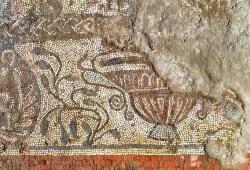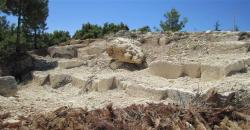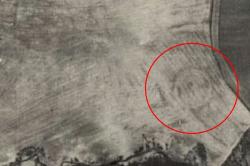INSTITUT SUPERIEUR D'ANTHROPOLOGIE
INSTITUTE OF ANTHROPOLOGY
ONLINE COURSES / COURS A DISTANCE
FALL TERM : OCTOBER 2017
REGISTER NOW
ROYAUME UNI –  Boxford - One of the UK’s most stunning Roman mosaics has been unearthed at an archaeological dig near Boxford. For the last three summer dig seasons, a project to map the area revealed a possible Roman villa site near Boxford, using records from when a drainage ditch was dug nearby in the 19th century. The mosaic is square-shaped, roughly 10 metres in length and on each side it has a half-metre border made from red roof tiles cut into cubes, called tesserae, forming a panel adjacent to the nearby interior walls. Although only one side has been revealed, it is clear that a central square of the mosaic is also covered in intricate ancient dioramas. Some of the classical figures uncovered read like a ‘who’s who’ of mythical icons, including Hercules, the god famous for his strength, Pegasus the winged horse, Cupid, the god of desire, and the Chimera, a fire-breathing beast. Tantalisingly, a few letters, probably Greek, have also appeared in a line close to where the archaeology stops and if funding for another dig becomes available, this will be fully revealed. Cotswold Archaeology’s chief executive Neil Holbrook said: “This is one of the best 4th-century classically-inspired Roman mosaics ever found in the country, which sends the message that the villa owner was well versed in Greek and Roman mythology.
Boxford - One of the UK’s most stunning Roman mosaics has been unearthed at an archaeological dig near Boxford. For the last three summer dig seasons, a project to map the area revealed a possible Roman villa site near Boxford, using records from when a drainage ditch was dug nearby in the 19th century. The mosaic is square-shaped, roughly 10 metres in length and on each side it has a half-metre border made from red roof tiles cut into cubes, called tesserae, forming a panel adjacent to the nearby interior walls. Although only one side has been revealed, it is clear that a central square of the mosaic is also covered in intricate ancient dioramas. Some of the classical figures uncovered read like a ‘who’s who’ of mythical icons, including Hercules, the god famous for his strength, Pegasus the winged horse, Cupid, the god of desire, and the Chimera, a fire-breathing beast. Tantalisingly, a few letters, probably Greek, have also appeared in a line close to where the archaeology stops and if funding for another dig becomes available, this will be fully revealed. Cotswold Archaeology’s chief executive Neil Holbrook said: “This is one of the best 4th-century classically-inspired Roman mosaics ever found in the country, which sends the message that the villa owner was well versed in Greek and Roman mythology.
http://www.newburytoday.co.uk/news/home/22229/spectacular-find-at-boxford-dig.html
TURQUIE –  Tabea - An approximately 2,000 year-old stone pit has been discovered in the ancient city of Tabea in the western city of Denizli’s Kale district. The municipal teams, which were trying to get fill material for a touristic castle under construction on the Kepez Hill, found a field with steps in the region. Head of ancient Tabea excavations and Pamukkale University (PAU) History Department Associate Professor Mustafa Beyazıt made examinations and determined the field could have been an ancient stone pit. Beyazıt said the stone types in the stone pit are the same with the stone blocks in the ancient city of Tabea.“We thought this field could not have been a theater. The steps on the rocks made us think this place could be a historic stone pit. We believe it dates back 2,000 years. We informed the Denizli Museum Directorate to make the field an archaeological site,” he said. Beyazıt said they found column pieces and stone blocks from different periods, adding that the field had served as a stone pit for a very long time.
Tabea - An approximately 2,000 year-old stone pit has been discovered in the ancient city of Tabea in the western city of Denizli’s Kale district. The municipal teams, which were trying to get fill material for a touristic castle under construction on the Kepez Hill, found a field with steps in the region. Head of ancient Tabea excavations and Pamukkale University (PAU) History Department Associate Professor Mustafa Beyazıt made examinations and determined the field could have been an ancient stone pit. Beyazıt said the stone types in the stone pit are the same with the stone blocks in the ancient city of Tabea.“We thought this field could not have been a theater. The steps on the rocks made us think this place could be a historic stone pit. We believe it dates back 2,000 years. We informed the Denizli Museum Directorate to make the field an archaeological site,” he said. Beyazıt said they found column pieces and stone blocks from different periods, adding that the field had served as a stone pit for a very long time.
http://www.hurriyetdailynews.com/stone-pit-found-in-ancient-city-of-tabea.aspx?PageID=238&NID=117459&NewsCatID=375
ROYAUME UNI –  Swords Castle - The remains of at least three burials have been found by volunteers digging history at Swords Castle. Not for the first time, the community archaeology project, now in its third year, has uncovered evidence of human remains buried within the castle walls. It was the volunteers in 'trench nine' at Swords Castle that made the discover as they were looking for the missing wall of the East Tower of the castle complex, but instead found at least three burials. Speaking about the extraordinary discovery, Christine Baker, Fingal's Community Archaeologist said: 'It is not the first time that burials have been uncovered at Swords Castle, however, the depth, just a few inches below the ground surface, is surprising. 'We know from previous works that an 11th century burial ground was here before Swords Castle was built.
Swords Castle - The remains of at least three burials have been found by volunteers digging history at Swords Castle. Not for the first time, the community archaeology project, now in its third year, has uncovered evidence of human remains buried within the castle walls. It was the volunteers in 'trench nine' at Swords Castle that made the discover as they were looking for the missing wall of the East Tower of the castle complex, but instead found at least three burials. Speaking about the extraordinary discovery, Christine Baker, Fingal's Community Archaeologist said: 'It is not the first time that burials have been uncovered at Swords Castle, however, the depth, just a few inches below the ground surface, is surprising. 'We know from previous works that an 11th century burial ground was here before Swords Castle was built.
http://www.independent.ie/regionals/fingalindependent/news/human-remains-found-at-castle-36076826.html
USA –  Lac Huron - Maritime archaeologists have discovered two shipwrecks that are more than a century old in Lake Huron. Officials with Thunder Bay National Marine Sanctuary announced Friday that they have confirmed the identities of the wooden steamer Ohio (1873-1894) and the steel-hulled steamer Choctaw (1892-1915). Officials say in May, a sanctuary-led expedition used high-resolution sonars to map the bottom of Lake Huron, during which they located the two ships. The team recently confirmed the vessels’ identities using underwater robots to collect photos and video of the shipwrecks.
Lac Huron - Maritime archaeologists have discovered two shipwrecks that are more than a century old in Lake Huron. Officials with Thunder Bay National Marine Sanctuary announced Friday that they have confirmed the identities of the wooden steamer Ohio (1873-1894) and the steel-hulled steamer Choctaw (1892-1915). Officials say in May, a sanctuary-led expedition used high-resolution sonars to map the bottom of Lake Huron, during which they located the two ships. The team recently confirmed the vessels’ identities using underwater robots to collect photos and video of the shipwrecks.
http://upnorthlive.com/news/local/maritime-archaeologists-discover-2-century-old-shipwrecks-in-lake-huron
INDE – Dhaavla - The Department of Archaeology has found a rare ancient idol of Sri Ganesha. This idol was dug out while cleaning out debris at Dhaavla village (Harrai gram panchayat) in Raisen district. Idols of Jain Chatushtika statue, Lord Shiva, Vishnu, Devi, Bhairav apart from remnants of four temples on the mountains have also come to light. Only the lower portions of the temples are intact. Giving this information Commissioner Archaeology Shri Anupam Rajan said that the ancient idol found during the cleaning dates back to the period between 11thcentury AD to 13th century AD.There is a huge ancient temple of Lord Shiva on the nearly 50 feet high mountain in the village. A shivalinga and a water base in the sanctum sanctorum has also come to light. Rajan told that several portions of the ancient temple including the shakha, sirdal, jangha, shikha besides several other idols have been unearthed by the technical team constituted by the department to clean up the debris.
http://www.dailypioneer.com/state-editions/bhopal/asi-finds-rare-ganesha-idol-in-raisen-district.html
ROYAUME UNI –  Kilwinning - Bizarre ‘crop circles’ in a Kilwinning field have been revealed as an ancient ritualistic building. Jeni Park was surprised when she stumbled across a 1950s map that showed two large concentric circles at Blair Ardoch farm. The Kilwinning Heritage researcher was scouring aerial photos when she uncovered a previously undiscovered feature. Now the feature, thought to be a henge, could be as ancient as 6000 years old. Jeni said: “I was surfing the National Library of Scotland website and was looking at the air photos. When I saw the two large ring marks in the empty field, I had a ‘could it be’ moment. She shared her findings with Kilwinning Heritage colleague Dr Ralph Shuttleworth, who agreed the marks looked man made, identifying them as parch marks caused by very small differences in the amount of moisture retained in the soil. Consultation with Kilwinning-based Rathmell Archaeology backed up their interpretations, and on site measurements revealed the circular feature was about 60 metres in diameter. The only way to be sure about the marks was to dig, and the first phase of investigation by Ralph, Jeni, and a very small team has now been completed.Their digging and scraping has revealed two shallow ditches about two metres wide and a substantial stone-lined hole for a timber post or stone upright of some kind within the inner ditch. Dr Shuttleworth, veteran of many archaeological digs all over the UK, said: “A feature with this form and size is called technically a henge, Neolithic or Bronze Age in date, so somewhere between 4000 and 6000 years old. “Henges can contain ritual structures such as stone or timber circles, in our case probably timber, and could have been used for worship or to honour the ancestors in some way.
Kilwinning - Bizarre ‘crop circles’ in a Kilwinning field have been revealed as an ancient ritualistic building. Jeni Park was surprised when she stumbled across a 1950s map that showed two large concentric circles at Blair Ardoch farm. The Kilwinning Heritage researcher was scouring aerial photos when she uncovered a previously undiscovered feature. Now the feature, thought to be a henge, could be as ancient as 6000 years old. Jeni said: “I was surfing the National Library of Scotland website and was looking at the air photos. When I saw the two large ring marks in the empty field, I had a ‘could it be’ moment. She shared her findings with Kilwinning Heritage colleague Dr Ralph Shuttleworth, who agreed the marks looked man made, identifying them as parch marks caused by very small differences in the amount of moisture retained in the soil. Consultation with Kilwinning-based Rathmell Archaeology backed up their interpretations, and on site measurements revealed the circular feature was about 60 metres in diameter. The only way to be sure about the marks was to dig, and the first phase of investigation by Ralph, Jeni, and a very small team has now been completed.Their digging and scraping has revealed two shallow ditches about two metres wide and a substantial stone-lined hole for a timber post or stone upright of some kind within the inner ditch. Dr Shuttleworth, veteran of many archaeological digs all over the UK, said: “A feature with this form and size is called technically a henge, Neolithic or Bronze Age in date, so somewhere between 4000 and 6000 years old. “Henges can contain ritual structures such as stone or timber circles, in our case probably timber, and could have been used for worship or to honour the ancestors in some way.
http://www.dailyrecord.co.uk/news/local-news/archaeologists-reveal-story-behind-ancient-11086071
FRANCE –  Limay - Si les Limayens connaissent bien l’histoire du Vieux pont, partiellement détruit pendant la seconde guerre mondiale, tous ne savent pas qu’un moulin s’y trouvait jusqu’au XIXe siècle. Depuis le début du mois de juillet, des plongeurs yvelinois s’affairent sous la Seine, au niveau de la quatrième arche du pont, pour retrouver l’origine de ce moulin dont la structure en pierre repose toujours dans la Seine. « L’ancien moulin a sombré en 1870 : pendant une crue, une péniche est venue heurter les pilotis du moulin et l’a détruit », raconte Pierre de Simon, responsable de ces fouilles archéologiques. La date de destruction connue, les plongeurs essayent de déterminer celle de sa construction. Sous l’eau, ils sont pour cela en train de dégager trois des plus de vingt pilotis en chêne encore accessibles. « On va ensuite scier des rondelles de bois, qu’on va transmettre à un scientifique, qui va les dater », détaille le responsable des fouilles archéologiques.
Limay - Si les Limayens connaissent bien l’histoire du Vieux pont, partiellement détruit pendant la seconde guerre mondiale, tous ne savent pas qu’un moulin s’y trouvait jusqu’au XIXe siècle. Depuis le début du mois de juillet, des plongeurs yvelinois s’affairent sous la Seine, au niveau de la quatrième arche du pont, pour retrouver l’origine de ce moulin dont la structure en pierre repose toujours dans la Seine. « L’ancien moulin a sombré en 1870 : pendant une crue, une péniche est venue heurter les pilotis du moulin et l’a détruit », raconte Pierre de Simon, responsable de ces fouilles archéologiques. La date de destruction connue, les plongeurs essayent de déterminer celle de sa construction. Sous l’eau, ils sont pour cela en train de dégager trois des plus de vingt pilotis en chêne encore accessibles. « On va ensuite scier des rondelles de bois, qu’on va transmettre à un scientifique, qui va les dater », détaille le responsable des fouilles archéologiques.
http://lagazette-yvelines.fr/2017/09/01/plongeurs-traces-de-lancien-moulin-vieux-pont/